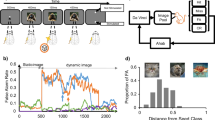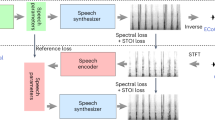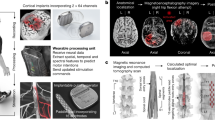Abstract
HIGH levels of speech recognition have been achieved with a new sound processing strategy for multielectrode cochlear implants. A cochlear implant system consists of one or more implanted elec-trodes for direct electrical activation of the auditory nerve, an external speech processor that transforms a microphone input into stimuli for each electrode, and a transcutaneous (rf-link) or per-cutaneous (direct) connection between the processor and the elec-trodes. We report here the comparison of the new strategy and a standard clinical processor. The standard compressed analogue (CA) processor1,2 presented analogue waveforms simultaneously to all electrodes, whereas the new continuous interleaved sampling (CIS) strategy presented brief pulses to each electrode in a nonover-lapping sequence. Seven experienced implant users, selected for their excellent performance with the CA processor, participated as subjects. The new strategy produced large improvements in the scores of speech reception tests for all subjects. These results have important implications for the treatment of deafness and for minimal representations of speech at the auditory periphery.
This is a preview of subscription content, access via your institution
Access options
Subscribe to this journal
Receive 51 print issues and online access
$199.00 per year
only $3.90 per issue
Buy this article
- Purchase on Springer Link
- Instant access to full article PDF
Prices may be subject to local taxes which are calculated during checkout
Similar content being viewed by others
References
Eddington, D. K. J. acoust. Soc. Am. 68, 885–891 (1980).
Eddington, D. K. Ann. N. Y. Acad. Sci. 405, 241–258 (1983).
Pfingst, B. E. Arch. Otolaryngol. 110, 140–144 (1984).
Shannon, R. V. Hear. Res. 11, 157–189 (1983).
Wilson, B. S., Finley, C. C. & Lawson, D. T. in Cochlear Implants: Models of the Electrically Stimulated Ear (eds Miller, J. M. & Spelman, F. A.) 339–376 (Springer, New York, 1990).
Eddington, D. K., Dobelle, W. H., Brackmann, D. E., Mladejovsky, M. G. & Parkin, J. L. Ann. Otol. Rhinol. Lar. 87, suppl. 53, 1–39 (1978).
Müller, C. G. Ann. N. Y. Acad. Sci. 405, 412–420 (1983).
Simmons, F. B. Arch. Otolaryngol. 84, 2–54 (1966).
Tong, Y. C., Blarney, P. J., Dowell, R. C. & Clark, G. M. J. acoust. Soc. Am. 74, 73–80 (1983).
White, M. W., Merzenich, M. M. & Gardi, J. N. Arch. Otolaryngol. 110, 493–501 (1984).
Wilson, B. S., Finley, C. C., Lawson, D. T. & Wolford, R. D. Proc. I.E.E.E. 76, 1143–1154 (1988).
Wilson, B. S., Lawson, D. T., Finley, C. C. & Wolford, R. D. Am. J. Otol. 12, suppl. 1, 56–61 (1991).
Clark, G. M. et al. Adv. Otol.-Rhinol. Lar. 38, 1–189 (1987).
Dorman, M. F., Hannley, M. T., Dankowski, K., Smith, L. & McCandless, G. Ear Hear. 10, 44–49 (1989).
Gantz, B. J. et al. Laryngoscope 98, 1100–1106 (1988).
Schindler, R. A. & Kessler, D. K. Am. J. Otol. 8, 247–255 (1987).
Tyler, R. S., Moore, B. C. J. & Kuk, F. K. J. Speech. Hear. Res. 32, 887–911 (1989).
Owens, E., Kessler, D. K., Raggio, M. W. & Schubert, E. D. Ear Hear. 6, 280–287 (1985).
De Filippo, C. L. & Scott, B. L. J. acoust. Soc. Am. 63, 1186–1192 (1978).
Owens, E. & Raggio, M. J. Speech Hear. Disorders 52, 120–128 (1987).
Robbins, A. M., Osberger, M. J., Miyamoto, R. T., Kienle, M. L. & Myres, W. A. J. Speech Hear. Res. 28, 565–578 (1985).
Sparks, D. W., Ardell, L. A., Bourgeois, M., Wiedmer, B. & Kuhl, P. K. J. acoust. Soc. Am. 65, 810–815 (1979).
Bess, F. H. & Townsend, T. H. J. Speech Hear. Disorders 42, 232–237 (1977).
Dubno, J. R. & Dirks, D. D. J. Speech Hear. Res. 25, 135–141 (1982).
Dowell, R. C., Seligman, P. M., Blamey, P. J. & Clark, G. M. Ann. Otol. Rhinol. Lar. 96, suppl. 128, 132–134 (1987).
Tyler, R. S., Preece, J. P., Lansing, C. R., Otto, S. R. & Gantz, B. J. J. Speech Hear. Res. 29, 282–287 (1986).
Flanagan, J. L. Speech Analysis, Synthesis and Perception (Springer, Berlin, 1972).
Hill, F. J., McRae, L. P. & McClellan, R. P. J. acoust. Soc. Am. 44, 13–18 (1968).
Remez, R. E., Rubin, P. E., Pisoni, D. B. & Carrell, T. D. Science 212, 947–950 (1981).
Rosen, S. in Cochlear Implant: Acquisitions and Controversies (eds Fraysse, B. & Cochard, N.) 3–26 (Impasse La Caussade, Toulouse, 1989).
Rosen, S. M., Fourcin, A. J. & Moore, B. C. J. Nature 291, 150–152 (1981).
Van Tasell, D. J., Soli, S. D., Kirby, V. M. & Widen, G. P. J. acoust. Soc. Am. 82, 1152–1161 (1987).
Author information
Authors and Affiliations
Rights and permissions
About this article
Cite this article
Wilson, B., Finley, C., Lawson, D. et al. Better speech recognition with cochlear implants. Nature 352, 236–238 (1991). https://doi.org/10.1038/352236a0
Received:
Accepted:
Issue Date:
DOI: https://doi.org/10.1038/352236a0
This article is cited by
-
An actor-model framework for visual sensory encoding
Nature Communications (2024)
-
Development of antibacterial neural stimulation electrodes via hierarchical surface restructuring and atomic layer deposition
Scientific Reports (2023)
-
Assessing the manufacturable 32-channel cochlear electrode array: evaluation results for clinical trials
Biomedical Microdevices (2023)
-
Computational analysis of multichannel magnetothermal neural stimulation using magnetic resonator array
Biomedical Engineering Letters (2023)
-
EAF-SR: an enhanced autoencoder framework for social recommendation
Multimedia Tools and Applications (2023)
Comments
By submitting a comment you agree to abide by our Terms and Community Guidelines. If you find something abusive or that does not comply with our terms or guidelines please flag it as inappropriate.



